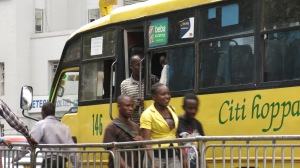So I’ve briefly mentioned matatus throughout my discussions on nairobi, but they deserve more attention than that. Matatus are such a part of the culture of nairobi and were part of the reason I became interested in the culture around urban transport all those many years ago. Matatus have such a strong culture around them that it is one of the biggest barriers to introducing any other forms of public transport. Some people are proud this culture, others less so, but everyone knows it’s there.
First of all, what is a matatu? Some refer to all buses and vans used for public transport as matatus while others look at it more like goldilocks. There are the big buses, which are too big to be called matatus and are hence called ‘buses’ (surprise surprise), there are minivans that are too small to be called matatus and are hence called ‘nissans’ (they are all secondhand or maybe thirdhand from japan) and then there are the colourful vehicles which are just the right size to be called matatus and they are hence called ‘matatus’.
Buses have set stops (or stages as they are called in Nairobi). So you wait, get on, find a seat and then the conductor comes around to collect your money, give you a ticket, and turn the funny contraption that looks like it’s come from a world where bigger and heavier machines were the bomb. The bus is filled with seats and the idea of standing is left to people hunching is minivans in rural areas. In most of the buses I caught, the atmosphere was quiet, there was occasional music and there was even sometimes people getting on the bus to sell their wares.
On matatus and nissans the ambience can vary drastically. There are those for business people that are quiet and serious. Some people talk I guess, or look at their phones, maybe listen to their own music. Then their are the matatus that are designed for particular audiences such as students. Here, noise is essential – and if there is a beat with so much base you can’t feel the bumps in the road – you know it’s going to attract the customers. People don’t just hop onto any matatu and the touts see that they make enough noise (they call it welcoming to whistle and yell at you) to ensure you choose the matatu they are touting for. So a matatu stage becomes a bit of a stage as the touts perform their acts of persuasion. Once you have clambered in, you might be waiting for the tout to fill up the vehicle before you go or if you’re lucky it is almost full (full one meant there was no excess air in the matatu, but now it just means the seats are filled up).
When the music is loud, you cannot talk to anyone unless you shout and everyone just bobs up and down to the music – there are often cushioned roofs – I guess that’s for if your bobbing becomes extreme. The decorations can mesmerise you for a while – with posters of rappers and general bling lining the walls of the matatus in all sorts of colours. These decorations and music are more than a way to attract customers, they are an important form of expressions with nairobi, with every nairobi driver taking pride in their vehicle.
I guess at the end of the day, what is so interesting about matatus is what they represent to the people of the city. Even when they are dangerous and loud, they still have a place in the hearts of the people of Nairobi. They are seen as part of the fabric of the city. I guess this is an important part of any transport system and something I’m searching for in cities around the world.




